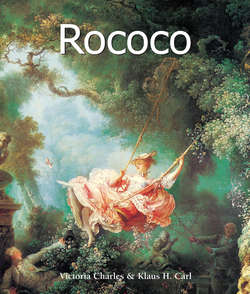Читать книгу Rococo - Victoria Charles - Страница 11
На сайте Литреса книга снята с продажи.
I. Rococo in France
Painting
ОглавлениеIn the 18th century, the cold representation of the pictures of 17th-century designs gradually began to give way to a warmer conception, which developed further and further, manifesting itself ultimately in a frivolity of expression. The era of Jeanne Bécu, better known as Madame du Barry (1743–1793), who bled to death on the guillotine to the howls of the rowdy population, of Jeanne-Antoinette Poisson, famous as Madame de Pompadour, yearned for different attractions from those of the age of the official royal mistress, Madame de Montespan (1640–1707). This marquise did have seven children with King Louis XIV, but was forced out of court by Madame de Maintenon, who then after a long battle against bankruptcy became the last mistress and later secret wife of the then-aged and tired Louis XIV.
French art in the 18th century finally discovered its own language, in which it could fully communicate its essence. Painting with oils was an extensive process. Pastel painting, developed as early as the 15th century, is painting with dry colour crayons, the rubbings of which settle onto the paper, which is then made wipe-proof with a fixative. The colours, particularly in portraits, seem to have been created for the representation of finely graduated, smoothly changing skin colours and the elegant clothing of this period. Pastel painting had been used earlier by Leonardo da Vinci (1452–1519), Hans Holbein the Younger (1497–1543) and others, but with far less wealth of colour nuance than that which was displayed by the Rococo painters. These pastel artists were almost exclusively portrait painters, and only occasionally did they represent individual mythological or genre figures from their lives or times.
François Boucher, Reclining Girl, 1752.
Oil on canvas, 59 × 73 cm.
Alte Pinakothek, Munich.
Antoine Watteau, The Bath of Diana (detail), c. 1715–1716.
Oil on canvas, 80 × 101 cm.
Musée du Louvre, Paris.
Noël Nicolas Coypel, The Birth of Venus, 1732.
Oil on canvas, 81 × 65 cm.
The State Hermitage Museum, St. Petersburg.
